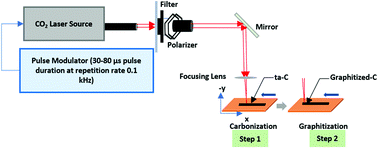当前位置:
X-MOL 学术
›
J. Mater. Chem. C
›
论文详情
Our official English website, www.x-mol.net, welcomes your feedback! (Note: you will need to create a separate account there.)
Improved conductivity of carbonized polyimide by CO2 laser graphitization
Journal of Materials Chemistry C ( IF 6.4 ) Pub Date : 2020/02/27 , DOI: 10.1039/c9tc05737d Ratul Kumar Biswas 1, 2, 3, 4, 5 , Nazar Farid 1, 2, 3, 4, 5 , Gerard O’Connor 1, 2, 3, 4, 5 , Patricia Scully 1, 2, 3, 4, 5
Journal of Materials Chemistry C ( IF 6.4 ) Pub Date : 2020/02/27 , DOI: 10.1039/c9tc05737d Ratul Kumar Biswas 1, 2, 3, 4, 5 , Nazar Farid 1, 2, 3, 4, 5 , Gerard O’Connor 1, 2, 3, 4, 5 , Patricia Scully 1, 2, 3, 4, 5
Affiliation

|
Direct laser writing (DLW) is a fast and cost-effective technique for printing conductive structures on flexible substrates such as polyimide (PI) by the conversion of insulative PI to conductive carbon. However, the conductivity (∼103 S m−1) obtained by this method needs to be improved to compete with ink-jet printing of carbon-based materials. The reason behind the low conductivity achieved by the DLW process is due to the crystallinity and hybridization of bonding in carbonaceous structures. In this work, the DLW process has been implemented in two steps: the first step called carbonization was performed by writing pulsed CO2 laser on PI to form tracks which consist of amorphous tetrahedral carbon (a mixture of sp2 and sp3 hybridized carbon) having intrinsically low conductivity. The second step called graphitization is overwriting of the laser on the pre-carbonized tracks to convert sp3 hybridized bonds to sp2 hybridized bonds by the process called laser graphitization. The conductivity of tracks carbonized at (0.21 ± 0.02) W and fluence (3.31 ± 0.32) × 103 mJ cm−2 at a repetition rate of 0.1 kHz was 56.1 ± 3.1 S m−1 which increased to 146.7 ± 5.1 S m−1 upon overwriting with the laser at (0.50 ± 0.03) W and fluence (7.88 ± 0.47) × 103 mJ cm−2 at the same repetition rate. The photothermal process of carbonization and graphitization is modeled for the DLW process and the threshold power of both the processes is calculated and validated by Raman spectroscopy. Improved conductivity achieved by detailed understanding of the laser and material parameters involved in this transformation enables process optimization leading to future applications in scalable manufacturing of flexible bio-sensors and electrochemical energy storage devices.
中文翻译:

通过二氧化碳激光石墨化提高碳化聚酰亚胺的电导率
直接激光写入(DLW)是一种快速且经济高效的技术,用于通过将绝缘性PI转换为导电碳,在诸如聚酰亚胺(PI)的柔性基板上印刷导电结构。然而,通过该方法获得的导电性(〜10 3 S m -1)需要提高以与碳基材料的喷墨印刷竞争。DLW工艺实现低电导率的原因在于碳质结构中的结晶度和键的杂化。在这项工作中,分两步实施了DLW工艺:第一步称为碳化,方法是在PI上写入脉冲CO 2激光以形成由非晶四面体碳(sp 2和sp的混合物)组成的磁道。具有固有低电导率的3杂化碳)。第二步称为石墨化,是将激光覆盖在预碳化的轨道上,以通过称为激光石墨化的过程将sp 3杂化键转换为sp 2杂化键。迹中的(0.21±0.02)碳化电导率W和注量(3.31±0.32)×10 3毫焦耳厘米-2在0.1千赫的重复率是56.1±3.1 S M -1增加至146.7±5.1 S M -用(0.50±0.03)W的激光和通量(7.88±0.47)×10 3 mJ cm -2覆盖时为1以相同的重复率。为DLW过程建模了碳化和石墨化的光热过程,并通过拉曼光谱法计算并验证了这两个过程的阈值功率。通过详细了解此转换涉及的激光和材料参数而获得的提高的电导率可实现工艺优化,从而导致可扩展制造的柔性生物传感器和电化学储能设备的未来应用。
更新日期:2020-04-03
中文翻译:

通过二氧化碳激光石墨化提高碳化聚酰亚胺的电导率
直接激光写入(DLW)是一种快速且经济高效的技术,用于通过将绝缘性PI转换为导电碳,在诸如聚酰亚胺(PI)的柔性基板上印刷导电结构。然而,通过该方法获得的导电性(〜10 3 S m -1)需要提高以与碳基材料的喷墨印刷竞争。DLW工艺实现低电导率的原因在于碳质结构中的结晶度和键的杂化。在这项工作中,分两步实施了DLW工艺:第一步称为碳化,方法是在PI上写入脉冲CO 2激光以形成由非晶四面体碳(sp 2和sp的混合物)组成的磁道。具有固有低电导率的3杂化碳)。第二步称为石墨化,是将激光覆盖在预碳化的轨道上,以通过称为激光石墨化的过程将sp 3杂化键转换为sp 2杂化键。迹中的(0.21±0.02)碳化电导率W和注量(3.31±0.32)×10 3毫焦耳厘米-2在0.1千赫的重复率是56.1±3.1 S M -1增加至146.7±5.1 S M -用(0.50±0.03)W的激光和通量(7.88±0.47)×10 3 mJ cm -2覆盖时为1以相同的重复率。为DLW过程建模了碳化和石墨化的光热过程,并通过拉曼光谱法计算并验证了这两个过程的阈值功率。通过详细了解此转换涉及的激光和材料参数而获得的提高的电导率可实现工艺优化,从而导致可扩展制造的柔性生物传感器和电化学储能设备的未来应用。



























 京公网安备 11010802027423号
京公网安备 11010802027423号